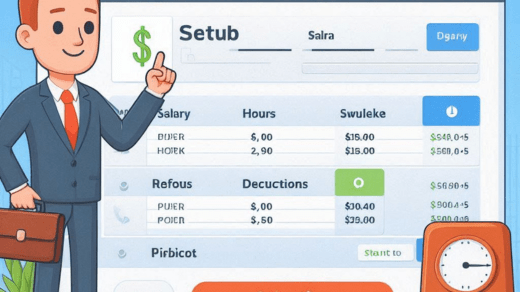Running a small business involves wearing many hats, and managing payroll is one of the most critical responsibilities. Paycheck stubs, also known as pay stubs or pay slips, are essential documents that provide employees with a detailed breakdown of their earnings and deductions. Creating paycheck stubs not only ensures compliance with legal requirements but also fosters transparency and trust with your employees.
Here’s a comprehensive guide on how to create professional paycheck stubs for your small business.
Understand the Importance of Paycheck Stubs
Paycheck stubs serve multiple purposes:
- Legal Compliance: Many jurisdictions require employers to provide detailed pay stubs.
- Employee Transparency: They offer employees a clear understanding of their earnings, deductions, and net pay.
- Record Keeping: Pay stubs are crucial for financial record-keeping and can be useful for tax purposes, loan applications, and other financial dealings.
Gather Essential Information
Before creating paycheck stubs, ensure you have the following information:
- Employee Details: Full name, address, and Social Security number.
- Employer Details: Company name, address, and Employer Identification Number (EIN).
- Pay Period: The start and end dates of the pay period.
- Hours Worked: Total hours worked or days worked during the pay period.
- Gross Pay: Total earnings before deductions.
- Deductions: Taxes, insurance premiums, retirement contributions, etc.
- Net Pay: The final amount the employee takes home after deductions.
Choose a Paycheck Stub Template
There are various ways to create paycheck stubs, including using templates, software, or manual methods. Opting for a professional template can save time and ensure accuracy. You can find templates online or use payroll software that includes paycheck stub functionality. Here’s what a good template should include:
- Header: Your company’s name, logo, and contact information.
- Employee Information: Employee’s name, address, and employee ID if applicable.
- Pay Period Dates: Clearly state the pay period.
- Earnings Breakdown: Itemize different types of earnings (e.g., regular pay, overtime, bonuses).
- Deductions Breakdown: List all deductions (e.g., federal tax, state tax, social security, health insurance).
- Net Pay: The total amount after deductions.
- Year-to-Date Totals: This section summarizes earnings and deductions for the current year up to the current pay period.
Use Payroll Software
For accuracy and efficiency, many small businesses use payroll software to generate paycheck stubs. Payroll software automates calculations, ensures compliance with tax laws, and produces professional-looking pay stubs. Popular payroll software options include:
- Gusto: Offers an intuitive interface and comprehensive payroll features.
- QuickBooks Payroll: Integrates with QuickBooks accounting software.
- ADP: Known for its scalability and range of payroll solutions.
- Paychex: Provides customizable payroll solutions for small to medium-sized businesses.
Manually Creating Paycheck Stubs
If you prefer a hands-on approach, you can manually create paycheck stubs using spreadsheet software like Microsoft Excel or Google Sheets. Here’s a step-by-step guide:
- Create a New Document: Open a new spreadsheet and set up columns for all necessary information.
- Design the Layout: Include sections for company and employee information, pay period dates, earnings, deductions, and net pay.
- Input Data: Enter the employee’s details, hours worked, and earnings. Use formulas to calculate totals and deductions.
- Format for Clarity: Make sure the stub is easy to read by using clear headings, consistent fonts, and sufficient spacing.
- Review for Accuracy: Double-check all figures and calculations to ensure they are correct.
Ensure Legal Compliance
Compliance with federal and state laws is crucial when creating paycheck stubs. Ensure that your pay stubs meet all legal requirements, including:
- Federal Requirements: The Fair Labor Standards Act (FLSA) mandates that employers provide pay stubs detailing wages, hours worked, and deductions.
- State Requirements: Some states have additional requirements, such as providing specific information on the pay stub or following certain formatting guidelines.
Check with your local labor department or a legal advisor to ensure your paycheck stubs meet all applicable regulations.
Distribute Paycheck Stubs
Decide how you will distribute paycheck stubs to your employees. Options include:
- Paper Pay Stubs: Hand them out with physical checks or pay envelopes.
- Electronic Pay Stubs: Email them securely or use a dedicated employee portal.
Ensure that whichever method you choose, it maintains the confidentiality and security of your employees’ information.
Keep Records
Maintain records of all paycheck stubs for at least three to seven years, depending on local regulations. This helps with audits, tax filings, and resolving any payroll disputes. Store physical copies in a secure location or use secure digital storage solutions.
Regular Updates and Reviews
Payroll laws and regulations can change, so it’s important to stay updated on any changes that might affect how you generate and distribute paycheck stubs. Regularly review your processes and tools to ensure they remain compliant and efficient.
Conclusion
Creating professional paycheck stubs is an essential part of payroll management for any small business. By understanding the importance of pay stubs, using the right tools, ensuring legal compliance, and maintaining accurate records, you can streamline your payroll process and build trust with your employees. Whether you choose to use software, templates, or a manual approach, the key is to provide clear, accurate, and timely information that reflects your employees’ earnings and deductions.

